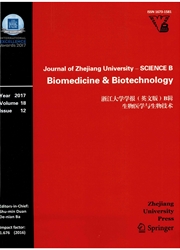

 中文摘要:
中文摘要:
near 红外线(NIR ) 因为它简单准备,快反应,和 non-destructiveness 的优点,光谱学技术在许多地里被使用了。我们为决定可溶的稳固的内容(SSC ) 和未经触动的枇杷的酸味(pH ) 在弥漫的反射模式调查了 NIR 光谱学的潜力。枇杷(Dahongpao 和 Jiajiaozhong ) 的二栽培变种从二收获了果园(Tangxi 和 Chun'an,浙江,中国) 被用于在 800 和 2500 nm 之间的 NIR 系列的测量。400 个枇杷(从每个果园的每栽培变种的 100 件样品) 的一个总数在这研究被使用。在枇杷的 NIR 系列和 SSC 和酸味之间的关系用部分最少的平方被评估(请) 方法。系列预处理选择包括了第一和第二衍生物,多重 scatter 修正(MSC ) ,和标准正常变量(SNV ) 。三分开光谱作为完整的 NIR (800 ∼2500 nm ) 识别的窗户,短 NIR (800 ∼1100 nm ) ,和 long NIR (1100 ∼2500 nm ) 与预处理选择在因素的联合被学习。模型给了枇杷的 SSC 的相对好的预言,与预言(RMSEP ) 的均方差分别地为 Tangxi-Dahongpao, Tangxi-Jiajiaozhong, Chun'an-Dahongpao,和 Chun'an-Jiajiaozhong 的 1.21, 1.00, 0.965,和 1.16 ° B rix 珍视的根。酸味预言不分别地是令人满意的,与为上述四个枇杷的 0.382, 0.194, 0.388,和 0.361 的 RMSEP。结果显示那 NIR 弥漫的反射光谱学能被用来预言枇杷水果的 SSC 和酸味。
 英文摘要:
英文摘要:
The near infrared (NIR) spectroscopy technique has been applied in many fields because of its advantages of simple preparation, fast response, and non-destructiveness. We investigated the potential of NIR spectroscopy in diffuse reflectance mode for determining the soluble solid content (SSC) and acidity (pH) of intact loquats. Two cultivars of loquats (Dahongpao and Jiajiaozhong) harvested from two orchards (Tangxi and Chun'an, Zhejiang, China) were used for the measurement of NIR spectra between 800 and 2500 nm. A total of 400 loquats (100 samples of each cultivar from each orchard) were used in this study. Relationships between NIR spectra and SSC and acidity of loquats were evaluated using partial least square (PLS) method. Spectra preprocessing options included the first and second derivatives, multiple scatter correction (MSC), and the standard normal variate (SNV). Three separate spectral windows identified as full NIR (800-2500 nm), short NIR (800-1100 rim), and long NIR (1100-2500 nm) were studied in factorial combination with the preprocessing options. The models gave relatively good predictions of the SSC of loquats, with root mean square error of prediction (RMSEP) values of 1.21, 1.00, 0.965, and 1.16 °Brix for Tangxi-Dahongpao, Tangxi-Jiajiaozhong, Chun'an-Dahongpao, and Chun'an-Jiajiaozhong, respectively. The acidity prediction was not satisfactory, with the RMSEP of 0.382, 0.194, 0.388, and 0.361 for the above four loquats, respectively. The results indicate that NIR diffuse reflectance spectroscopy can be used to predict the SSC and acidity of loquat fruit.
 同期刊论文项目
同期刊论文项目
 同项目期刊论文
同项目期刊论文
 期刊信息
期刊信息
